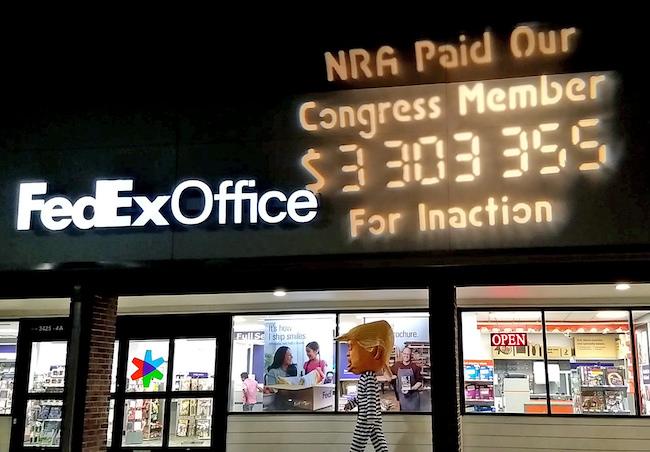Lessons from Hurricanes: Unlocking Community-Scale Resilience After Katrina, Sandy and Maria


As Hurricane Michael—among the strongest storms ever in the U.S.—fades from the headlines and long-term recovery efforts begin, we can glean lessons from past hurricane rebuilds. Small towns were among the hardest hit by Michael and could be the slowest to recover. Here’s the major lesson: after the FEMA trailers depart, resilience in small-town America requires good governance.
The nonprofit I work with, the Institute for Building Technology and Safety (IBTS), for instance, has quietly helped hundreds of smaller communities around the U.S. for 40 years after disaster strikes. Here, some of their experts weigh in on how good governance builds resilience.
1. A rethink of building codes can increase resilience.
Building code revisions, coupled with building code capacity-building, can lead to systemic resilience for small- and medium-sized cities. Following Hurricane Katrina, the state of Louisiana—which had no uniform building codes prior to the storm—determined that best practice includes an intense focus on systems, from management and operational to service delivery. These systems improve when open communication and relationships are nurtured between enforcement, builders and contractors with an emphasis on knowledge-brokering about the law and best practice. The need for training of these three groups—and homeowners—in the benefits of codes and their application proves key for these relationships to remain productive and for the systems to work, especially post-disaster.
IBTS’s Greg Blount notes, “A key to lessening the burden post-disaster on the 11 Louisiana parishes most acutely affected by Hurricane Katrina was to ensure that new homes were built to a code that anticipates future catastrophic storms. We found that homes built to the new code were 65 percent less likely to sustain damage during hurricanes.”
2. Post-disaster stability requires cooperation.
Interrelationships between governance structures, both in terms of triggers for cascading failures and inspirations for mutual support, can help to begin to stabilize jurisdictions. Governance processes include public works, community participation, finance, human resources and technology, all of which can fail or be severely tested during an extreme event.
Engaging with over 70 communities throughout Puerto Rico, my colleagues and I witnessed that—after the initial shock of Hurricane Maria’s devastation,—leaders and community members alike were ready to focus on planning, infrastructure, security and schools. Putting these issues on the table together helped identify unexpected benefits and priorities.
3. Listening to the community is key.
Community process, starting with listening to constituents, leads to a focus on the essence of what matters for quality of life. That may be a connection between recovery and historic preservation or green infrastructure as a community amenity with multiple functions. IBTS’ Blake Radcliff is a veteran of many disaster recoveries who focuses on ensuring economic development as an outcome of disaster recovery.
“Listening to homeowners in bedroom communities like Breezy Point as part of efforts to ‘bounce forward’ after Hurricane Sandy in New York gave significant momentum to home rebuilding," Radcliff said. "Some communities were determined to preserve historic characteristics, while others were determined to create green infrastructure amenities. In both cases, their determination propelled the government need to retrofit and rebuild homes ready for the next storm.”
The bottom line
These are important lessons to draw from prior storms to reduce the heartache and loss for the thousands of families collecting what they can and working on the process of getting their lives back together. They will be better able to do so with governance structures that support their resilience.
Image courtesy of the Institute for Building Technology and Safety
Water.org, Bank of America Partner to Bring Safe Water and Sanitation to India and Brazil


A water point in the yard allows Gandhimery and her neighbors in Pillayarkuppam, India, to avoid a 45-minute walk to the nearest community water source.
Water.org received a $3 million grant over three years from Bank of America to unlock safe drinking water and promote sanitation practices for more than 250,000 people in India and Brazil. The grant will enable Water.org to effectively expand its microfinance practice, WaterCredit, which gives small loans to people struggling to afford essential sanitation systems like water connections and toilets.
Water.org, a nonprofit organization co-founded by Gary White and actor Matt Damon, will use $2 million of the grant to provide market-based solutions to people in India. The remaining $1 million will be deployed in Brazil, where 5 million people lack access to safe water and 25 million lack access to improved sanitation. Last year, Water.org certified its first microfinance institution in Brazil and is looking to scale up its WaterCredit initiative “in this new, top-priority geography.”
India’s struggle with sanitation is well documented—the United Nations reported that nearly 600 million of India’s 1.3 billion people openly defecate. The solid waste from open defecation often finds its way into waterways that are used for drinking and cooking water. This puts hundreds of millions of people at risk of contracting a slew of diseases, including cholera and diarrhea. In India, the World Bank links one in 10 deaths to poor sanitation.
Water.org has worked in India since 2005, using its staple WaterCredit microfinance initiative to help more than 7 million people access safe water and sanitation.
The Indian government is also looking to combat open defecation—albeit using controversial methods of public shaming and a “take the poo to the loo” campaign. Prime Minister Narendra Modi has made it a top priority to end open defecation, ambitiously vowing that every Indian will have access to a toilet by October 2019. One financial report showed that India spent $106.7 billion in 2015—or 5.2 percent of its GDP—to build latrines, promote safe sanitation and install toilets.
Water.org’s market-based approach goes beyond providing people in need with sanitation solutions. Distributing loans to rural, often unbanked people gives them the opportunity to repay the loan and build credit, credit that they may use to leverage a future loan and start a small business.
Improved water access also frees up time, particularly for women. UNICEF found that women and girls around the world spend 200 million hours each day collecting water. The hours saved collecting water for their families, coupled with the time not spent caring for their constantly ill children, could unlock new economic and educational opportunities for women and girls.
“Just imagine—those 200 million hours add up to 8.3 million days or more than 22,800 years,” said Sanjay Wijesekera, UNICEF’s global head of water, sanitation and hygiene. “It’s as if a woman started with her empty bucket in the Stone Age and didn’t arrive home with water until 2018.”
Image credit: Water.org via Flickr
Digital and the Sustainable Development Goals: An Urgent Call to the World’s Donor Countries


Charlotte Petri Gornitzka co-authored this story
In a meeting last month co-hosted by the OECD’s Development Assistance Committee (DAC) and the GSMA, it was revealed that only half of the world’s 30 major donor aid agencies have a public Digital for Development (D4D) strategy to integrate digital technologies into their development policies.
This is an extraordinary finding, given the world that we live in. The rapid spread of digital technologies, and mobile in particular, has been a phenomenal success story. Today, over 5 billion people on the planet have a mobile subscription, with 3.7 billion subscribers living in low- and middle-income countries.
Mobile technology provides core digital infrastructure around the world. In the agricultural sector, mobile provides information and access to markets—enabling farmers to increase their crop yields, reduce pesticide use and increase family income. Mobile technologies, including the Internet of Things, are enabling increased access to safe water, sanitation and energy. And mobile money is offering a transformative digital solution for the world's financially excluded; at the end of 2017, there were 690 million registered mobile money accounts worldwide, and mobile money providers are now processing over $1 billion a day.
Through the Sustainable Development Goals (SDGs), the world has made an ambitious commitment to eradicate extreme poverty by 2030. While digitalization and mobile technology are not explicit targets within the SDGs, mobile connectivity and the services it enables hold great potential to accelerate all 17 goals. Indeed, the mobile industry was the first sector as a whole to commit to the SDGs.
That digital is an essential accelerator and delivery mechanism for the SDGs was reinforced when United Nations Secretary-General António Guterres created the High-Level Panel for Digital Cooperation in July of this year. Chaired by Melinda Gates, co-chair of the Bill & Melinda Gates Foundation, and Jack Ma, executive chairman of Alibaba Group, the Panel underscores that the scale, spread and speed of change brought about by digital technology is unprecedented—and, perhaps more importantly, that the current means and levels of international cooperation are unequal to the challenge.
We see several immediate opportunities. First, digital solutions can significantly improve the effectiveness and efficiency of existing development programming. Secondly, it is critical that we increase digital inclusion by ensuring that underserved populations can make best use of available technology, in particular women, older people, those with disabilities and rural populations. Finally, we need to build stronger partnerships between the technology industry and the development community to bring digital inclusion to the fore.
Advancing the SDGs requires governments to recognize that mobile connectivity and innovative digital technologies offer the promise of social and economic progress for millions of people at a speed unimaginable without mobile networks.
As 2030 approaches, there is an ever-pressing need for the world’s major donor countries to adopt digital strategies, to boost impact on each individual reached and drive scale to reach all those most in need, across their collective annual spend of nearly US$150 billion for official development assistance. We are already witnessing leading examples of bold ambition in development cooperation with the transformative use of mobile technologies—but to deliver the SDGs, we must all work together to ensure that this transformation becomes reality.
Image credit: Alix Murphy/WorldRemit via Flickr
Co-author Charlotte Petri Gornitzka was elected as Chair of the Development Assistance Committee (DAC) in 2016 to lead reform efforts of the DAC to support members in delivering on the SDGs. Prior to this, she served as Director-General of the Swedish International Development Co-operation Agency (SIDA) between 2010 and 2016 where she reaffirmed Sweden’s role as leader in development co-operation and spearheaded the implementation of innovative models to stimulate private sector engagement in development activities. She was recently appointed Deputy Executive Director at UNICEF. You can follow her on Twitter @CharlottePetriG.
Financial Activists Leverage Capital for Good


Magic happens when trailblazing financial activists come together. Freed from their geographical and professional silos, they develop strong coalitions to shift the flow of capital in ways that create powerful social and environmental benefits.
That’s the purpose of the Integrated Capital Institute, a nine-month fellowship program that gives finance professionals the strategies and insights they need to leverage capital in all its forms to effect lasting, positive change—launched last year by my organization, the nonprofit socially responsible investment group RSF Social Finance.
Current financial systems and incentives focus on maximizing short-term returns for wealth holders and do not include concerns for nature and economic equity. RSF’s Integrated Capital Fellows believe a different paradigm is possible—one that prioritizes long-term benefits to all stakeholders, including local communities, employees, customers, investors and the environment.
The urgency of addressing climate change and economic inequity calls for bold actions by those who understand the power and potential of capital to chart a different path.
Innovative thinkers seeking solutions
Investors, donors and wealth advisors are craving new solutions. Many who work in the world of finance are feeling disillusioned, thinking, “This is not working; I am not helping.” At the same time, investors and donors are realizing that it’s possible to have more than enough wealth, and they’re looking for financial practitioners who know how to leverage capital to support their values. Empowered by the great generational wealth transfer underway, people are ready to put money behind groundbreaking solutions.
The 22 Integrated Capital Fellows in RSF’s first cohort are activating resources—pulling together giving, lending, investing and field building—to direct capital flow in ways that create significant change. They’re committed to building social and economic justice, having uncomfortable conversations about money, and creating effective coalitions. Collectively, our Fellows have the potential to move billions of dollars toward world-changing initiatives.
They are part of a growing movement of investors, donors, financial activists and educators who are using new strategies to leverage financial, human and social capital to have the greatest positive effect on communities, individuals and future generations. Below are just a few examples of the important initiatives they are leading.
Moving from extraction to regeneration
Integrated Capital Fellows Stephanie Randolph and Lora Smith are working to support a successful economic transition in Central Appalachia, in collaboration with the Appalachia Funders Network—an organization committed to developing more diverse and resilient local economies.
Randolph serves as a program officer at Cassiopeia Foundation, a philanthropic investment fund. She developed Impact Appalachia to accelerate sustainable market development in the six coal-impacted states by blending $17 million in catalytic capital to unlock a $40 million investment fund. Smith, executive director of the Appalachian Impact Fund, makes grants and direct impact investments that support community-led economic development.
Flowing capital to underserved communities
Fellows Jessica Norwood and Nina Robinson are co-leading an exciting integrated capital fund called The Runway Project. It bridges the racial wealth gap by providing innovative funding and wealth-building tools designed to replicate “friends and family” funding for early-stage ventures led by African American entrepreneurs.
That essential seed stage of funding is not an equal-opportunity resource. White families in the U.S. have an average net worth of $142,000, while African American families have an average net worth of $11,000. The Runway Project provides affordable loans, along with culturally relevant technical support, to promising African American entrepreneurs. The project has provided financial and human capital to 12 companies in a range of industries.
In the Pacific Northwest, Nita Shah, founder and executive director of Micro Enterprise Services of Oregon (MESO), matches entrepreneurs from underserved and unbanked communities with the services and support needed to succeed in business. MESO has provided $5 million in loans to 611 entrepreneurs and placed over $2.5 million in matched savings.
Partnering across race and class
Tiffany Brown and Kate Poole became business partners during our Integrated Capital Institute. They are co-founders of a new financial advising firm called Chordata Capital, where they work with inheritors to balance present and future needs with a desire to address the extractive history of wealth accumulation.
Brown and Poole use an integrated capital approach, and they each bring over a decade of work in movements for racial and economic justice. Their work helps individuals and organizations collaborate across race and class to move their money in powerful ways.
Growing momentum
Leveraging capital to effect lasting change is more art than science and relies on leadership, innovation and collaboration more than just technical financial skills. Those qualities are what our Integrated Capital Institute aims to cultivate and spread. The second Integrated Capital Institute cohort, convening November 2018 to June 2019, will provide 24 financial activists with the connections and insights they need to leverage financial, human and social capital to address our most pressing social and environmental problems.
No one can solve these problems alone, but we begin to turn the tide when we question assumptions about money, engage in radical collaboration, and move capital where it’s needed most.
How Market Levers for Clean Energy Development are Continuing the Trend Toward Renewables


This article series is sponsored by NRG Energy and produced by the TriplePundit editorial team.
The renewable energy industry has come a long way since 1975, when the first utility-scale wind generation project came online in California. By the end of 2017, all renewable energy sources provided about 17 percent of total utility-scale power generation in the U.S., with about 10 percent of this total coming from wind and solar facilities.
While 17 percent may not sound like a lot, it’s double the amount from 10 years earlier. And over this same period, power generation from burning coal declined from about 45 percent of the U.S. total to 30 percent in 2017.
This trend is likely to continue according to most energy industry experts as costs continue to drop for renewables and as operating coal-burning plants becomes increasingly uneconomic.
So how did we get here? Over time, several factors have emerged, both at the federal and state levels, to support the growth of utility-scale renewable energy projects. Among the most important are federal tax incentives and state-mandated Renewable Portfolio Standards.
Tax Incentives and Renewable Portfolio Standards
For many years, the U.S. government has provided tax incentives to encourage domestic fossil fuel production. Starting in the mid-2000s, the government began offering similar incentives for renewables.
Chief among these are the Production Tax Credit (PTC) and Investment Tax Credit (ITC), which provide a 30 percent federal tax credit for the owners and investors in renewable energy generation projects. A 10 percent credit applies to other technologies like geothermal and combined heat and power systems. The industry has boomed since the introduction of these credits; however, they are set to decline or expire by 2022.
At the state level, Renewable Portfolio Standards (RPS) require state utilities to obtain a percentage, or specified amount, of the electricity they sell from renewable resources. Currently 29 states and the District of Columbia have such standards. According to recent estimates, roughly half of the growth in U.S. renewable energy generation since 2000 can be attributed to these RPS programs.
Price Parity and Beyond
Today, even without tax subsidies, solar and wind power are often cheaper than electricity generated by coal or nuclear over a facility’s lifetime. Likewise, natural gas prices, which were highly volatile in the early 2000s, have now stabilized making it a more economical choice for generating electricity versus coal.
As a result, many electric utilities are moving away from coal and increasing investments in renewables and high-tech natural gas-fired power plants that emit much less carbon dioxide (CO2) than existing plants.
In fact, the number of coal plants has been declining for some time, and as of late 2017, the number closing exceeded those still open. Another 43 gigawatts, or about 18 percent of the remaining 249 gigawatts of capacity, is expected to close by 2030. (A gigawatt powers about 700,000 homes.)
Moving Forward
Even with federal tax incentives sun-setting, industry watchers expect state programs, like RPS, will continue to drive clean energy development while other market forces will come forward.
Carbon Pricing
Many clean energy advocates are pushing for widespread carbon pricing plans like market-based cap-and-trade schemes. Such programs have already been implemented in the Northeast and Mid-Atlantic states through the Regional Greenhouse Gas Initiative (RGGI) and in California through Assembly Bill (A.B.) 32.
The California program has proven effective. State officials recently announced greenhouse gas pollution in California fell below 1990 levels for the first time since emissions peaked in 2004.
Corporate Demand
Another key market driver is the growing demand from the largest electricity consumers in the commercial and industrial sectors. Currently, 71 of Fortune 100 companies have set renewable energy targets, with 22 of those committing to procure 100 percent of their energy from renewable sources.
The accounting firm, Deloitte, recently surveyed over 600 businesses across industries and found that nearly half of business respondents are working to procure more electricity from renewable sources.
Increased Competition
Based on rules created by the Federal Energy Regulatory Commission (FERC), several states today offer some form of electricity market deregulation at the wholesale or retail level or both.
In deregulated wholesale markets, companies other than the utility can operate power plants and transmission lines. These companies compete to sell electricity into a wholesale market for retail energy suppliers to purchase and sell to their customers. Deregulation at the retail level means retail customers (commercial, industrial, residential) can choose between different retail suppliers, who compete to provide customers with technologies, solutions and options beyond “one size fits all” electricity.
Many in the industry, like Abe Silverman, vice president and deputy general counsel at NRG Energy, believe competitive markets have already demonstrated their impact on renewable energy development as most of the country’s wind and solar power plants are currently located in wholesale power markets.
As power generators look to replace aging power plants, Silverman believes, “competitive energy markets—not Washington—should decide where scarce investment dollars are spent and which technology mix will prevail.”
Headwinds?
But it won’t be all smooth sailing going forward if the current administration continues to implement coal-friendly policies while downplaying the role of renewables. Withdrawing from the Paris Climate Agreement, repealing the Clean Power Plan, imposing tariffs on solar panels – all these actions could slow progress.
In September 2017, the Department of Energy directed FERC to create a bailout plan for uncompetitive coal and nuclear plants couched in the premise that power plants with fuel located on site are needed to guarantee “grid resiliency.” FERC rejected this proposal in January 2018 saying there was no evidence that power plant retirements affect grid resilience.
Since then, the administration has continued to develop plans to bail out coal and nuclear plants. A draft of one such plan suggested that Cold-war era laws could be used to create a “strategic electric generation reserve” by compelling grid operators to buy electricity from at-risk fossil fuel plants. As of October, it seems that the administration has shelved this plan, but no official announcement has been made.
What’s next?
It seems that with or without federal-level support, market forces will continue to promote growth in low-carbon technologies. Customers large and small are voicing—with their wallets—that renewables continue to be economically and environmentally attractive and the power sector is responding.
Image: Pexels/Narcisa Aciko
3BL Forum Offers Insight Into Brands Taking Stands 3.0


The annual 3BL Forum has come and gone, but its impact will reverberate throughout the corporate responsibility field for some time to come. For the more than 300 CR professionals, CEOs, sustainability executives, and journalists who gathered at the MGM National Harbor, just outside Washington, D.C., the 3BL Forum was a fast-paced, idea-packed two days of panels, breakout sessions, issue tables, one-on-one interviews, and networking. Surprising analysis, new research, opinionated viewpoints, and frank commentaries—this conference was a business as unusual meeting from start to finish. Arguably, what got discussed at the event was a 3.0 version of Brands Taking Stands, one in which companies announced a wide variety of approaches to the rapidly evolving complexities of this still nascent movement.
Titled “Brands Taking Stands — The Long View,” the agenda delivered many deep insights as promised, but also offered perspectives as broad as they were deep.
That wider view was on display in the Town Hall session, which brought together senior corporate leaders and journalists to explore various stances within the overall concept of brands taking stands. Sherrie Deane, executive director of the National Basketball Players Association Foundation, voiced her organization’s principle of supporting all NBA players who take public positions, including those with right-wing views. Eli Stokols, White House reporter for the Los Angeles Times, laid out the conundrum of covering a deliberately confrontational administration, which forces journalists to question their tradition of objectivity. Jessica Herrera-Flanigan, EVP of government and corporate affairs for Univision Communications, told the backstory of how the Spanish-language television network became the first corporation to pull away from the current administration by cutting broadcasting ties with the Trump Organization, because of anti-immigrant remarks made when Donald Trump announced his candidacy. And this was just half of this provocative panel’s exchange.
Also eye-opening were presentations by companies not often considered through a CR filter. In a one-on-one interview which I conducted with Altria’s Jennifer Hunter, we discussed the sobering issues of harm reduction and underage tobacco use, and how the company has focused on those health issues with major programs. On a panel about legacy firms, Smithfield Farms’ Bill Gill talked about that company’s responsibility for operational excellence and innovation in a meat packing industry with a low reputation for both. Confirming their respective commitments at the Forum, both companies made subsequent announcements that matched actions to their words.
Altria announced that it would discontinue most of its flavored e-cigarettes and stop selling some brands altogether, in response to concerns about their use by youth. The company also pledged to support federal legislation to raise the age to buy any tobacco or vaping products to 21.
Smithfield announced plans to cover 90 percent of its hog waste lagoons in North Carolina, Missouri and Utah within the next 10 years to protect the pits from heavy rains, such as those from Hurricane Florence that caused flooding and environmental concerns. Smithfield also plans to use new technology to capture methane for generating renewable natural gas, supporting Smithfield Renewables, its year-old biogas initiative aimed at reducing greenhouse gas emissions by 25 percent by 2025.
These two case studies offered new ways to think about what taking a stand might mean, in both concept and operations.
The Forum’s highlight was the CR Magazine Responsible CEO of the Year Awards, given in several categories. Some notes on the winners, by the numbers:
- Aflac’s Dan Amos announced that the insurance company intends to provide a robotic, therapeutic plush duck to every U.S. child, aged 3 to 13, who is diagnosed with cancer.
- Jose Andres’ World Central Kitchen, winner of the Humanitarian Award, has served 4.5 million meals to those affected by Hurricanes Maria and Florence.
- Danone North America completed its B Corp certification within one year (it usually takes three); with over $6 billion in revenue, it is now by far the largest B Corp, said CEO Mariano Lozano.
- VF Corporation’s Steve Rendle spoke about leveraging its 20 apparel brands and 70,000 employees to shift from selling to retailers to selling directly to consumers.
- PwC’s JC LaPierre announced that 550 CEOs are now signed up for CEO Action for Diversity and Inclusion, an initiative kickstarted by CEO Tim Ryan.
- BCD’s John Snyder spoke about creating a company and a community for the next generation of its 13,500 global employees.
The variety of initiatives and their large scale spoke to the mainstreaming of CR throughout industries and sectors. All sorts of brands are now taking various “stands” to make progressive change—that was the bottom line of the Awards dinner.
There were many more ideas, insights, and comments on display at 3BL Forum worth thinking about at length—talk about “the long view!” For more about the 3BL Forum, “Brands Taking Stands — The Long View”:
- Videos of the presentations will be posted shortly at 3BL Forum.
- Articles about Forum issues can be found here.
- You can see the full agenda of the 2018 Forum here.
Four Need-to-Know Insights From the 2018 3BL Forum


Last week, business executives, nonprofit leaders, government officials and issue advocates met in National Harbor, Maryland, for the annual 3BL Forum (formerly Commit!Forum). The theme of the conference was again “Brands Taking Stands.” Yet this year, companies unpacked if, when and how they take stands, so others in the audience could learn from leaders in the field. CEO Shana Deane kicked off this year’s conference by commending the nerve and grit of brands willing to speak up on divisive issues and discussing how this movement has reached new levels.
Didn’t make it to this year’s Forum? Here are the four need-to-know insights from the event:
1. Leaders must encourage other leaders.
A highlight from the conference was a CEO-centric session featuring Mariano Lozano, CEO of Danone North America, and Steve Rendle, chairman and CEO of VF Corp. The leaders shared insights into how they are guiding their organizations with purpose, but they also called on others to join the movement. Lozano drove this point home when describing the company’s huge achievement of becoming the world’s largest B Corp. Lozano simply stated, “We are the biggest B Corp worldwide, for the time being. Soon we hope to become second to another company.”2. Profitable sustainability sells.
Legacy companies representing more than 400 years of business took the stage for the session, “Perspective from Legacy Companies: Innovations in Corporate Thinking.” Michael Okoroafor, vice president of global sustainability and packaging innovation at McCormick & Co., shared the company’s approach, including a concept it calls Purpose-led Performance—which means the brand is equally dedicated to strengthening its business and improving the world around it. This has allowed the heritage brand to remain competitive over the years, while also focusing on the betterment of the planet and society.3. Go big, then adapt.
When describing “The Ready Commitment,” TD Bank’s $1 billion commitment to open doors for a more inclusive tomorrow, Andrea Barrack, the company's vice president of global corporate citizenship, drove home an important takeaway for the audience on how TD will reach its goal by 2030. “We have agreed on the vision and the goals and we’re going to hold people accountable. The details on how we get there need to be adaptable.” This means customizing the program to different regions, as well as reporting out customized progress metrics based on audiences.4. Civic engagement is transforming employee engagement.
In a session entitled “Brands and Their Employees on the Front Lines of Social Change,” Natalye Paquin, president and CEO of Points of Light, and Jenny Lawson, chief civic innovation officer at Points of Light, shared insights into the changing landscape of employee engagement. Lawson called out how engagement is spreading beyond the office, noting that although only 24 percent of employees reported they volunteer. More than 60 percent are “giving back” in other ways. She gave examples such as purchasing from companies employees believe in and choosing to work at companies with values that align with their own. Businesses must understand this new dynamic and encourage myriad types of engagement that inspire employees to contribute to issues they are passionate about in the ways they want to get involved.The bottom line
As the conference neared a close last Thursday, a Town Hall session explored the concept of brands taking stands as either a moment or a movement. Most experts agreed it was a movement—and one continuing to gain traction. And until we reconvene at 3BL Forum 2019, we’ll be sure to track the evolution of this movement, because as Sherrie Deans, executive director of the National Basketball Players Association Foundation, put it: “Few of us have the option to stay on the sideline.”This story was originally published at "Insights,” Cone Communications.
Brands Taking Stands: FedEx Fills a Leadership Void, Intentionally or Not


The corporate social responsibility movement has been ramping up to a new level over the past two years, as leading consumer brands take steps to address the reputational risk of associating with right wing extremism. One significant development occurred on the heels of last week's hate-fueled violence - FedEx has announced that it will no longer provide a shipping discount to the National Rifle Association.
To be clear, the break is between FedEx and its broader marketing program, which includes the NRA organization among many others. The company has stated that it will still provide discounts to individual NRA members. Nevertheless, there is more to that announcement than meets the eye.
Brands (not) taking stands
FedEx came in for a good deal of criticism over its relationship with the NRA long before the trio of violent episodes erupted last week, including a series of failed package bombs in New York and other cities, the deadly shooting of two shoppers in Kentucky and the massacre of 11 people at a synagogue in Pennsylvania.
Back in January 2017, an alliance of gun control organizations drew attention to the connection between FedEx's robust delivery business with gun dealers in Florida, the state's notorious "stand your ground" law enabling citizens to use deadly force and a spike in homicides that some researchers have linked to passage of the law.
The pressure turned up considerably higher with the murder of 17 people at a high school in Parkland, Florida earlier this year.
Rather than letting adults spearhead the reaction, students at the school took the lead with an informed, passionate appeal for gun control that resonated nationwide.
Major brands, most notably Dick's Sporting Goods, quickly withdrew from their relationships with the NRA. The list of those making a swift, public withdrawal included the First National Bank of Omaha, rental car companies including Enterprise, Hertz and Avis, the purchasing service TrueCar, airlines United and Delta, cybersecurity companies SimpliSafe and Symantec, the Wyndham Rewards program of Wyndham Hotels, MetLife Insurance, Allied Van Lines and NorthAmerican Van Lines.
The list of household brands did not include FedEx, which may have been hoping that the public spotlight on the Parkland murders would soon dim, just as it has in so many other cases.
Brands taking stands: when boycotts work
So, what finally prompted FedEx to drop marketing ties with the NRA after last week's violence?
It could have simply been a case of the very last straw. The Oval Office is occupied by a president who has populated his inner circle with people sympathetic to the white nationalist movement, and who gins up fear, anger and paranoia as a matter of routine, promoting an undercurrent of state-approved violence and resentment. It was only a matter of time before that influence propagated from online bullying and rally-goer chanting into the real world.
The reaction of other brands may have also motivated FedEx to take a stand. In the wake of the Pittsburgh massacre, the killer's affinity with the extremist social media platform Gab came to light and brands were caught in the reflection.
Consumer brands had already kept Gab at a distance from the get-go, and Microsoft had already cut off Gab from its hosting service Azure. The site's current host, Joylent, swiftly closed out the account after the massacre. PayPal and Stripe were already beginning to disentangle their services from Gab, and both companies brought the process to a swift conclusion after the massacre.
This kind of reaction takes corporate social responsibility into a new level of activism, in which brand risk is deeply entwined with issues of broad social concern that are not being addressed by elected decision makers.
Reputational risk and the bottom line
Whether or not brand risk and brand activism were significant factors, FedEx has chosen to downplay its decision as a bottom-line strategy.
The NRA decision was slipped into a group of 100 organizations that formerly received FedEx discounts.
As reported by Local 24 News in Memphis, Tennessee, FedEx provided this explanation:
We are transitioning some account holders in more than 100 organizations in the FedEx Marketing Alliance program to other pricing programs. Account holders that participated in the program will continue to receive the same discounts on FedEx shipping, and we will work directly with these customers to ensure a seamless transition.”The New York Times provided more details:
...FedEx said on Tuesday that its decision to end its marketing relationship with the N.R.A. was the result of a review that began months ago. The review showed that members of the group did not bring in enough shipping volume to warrant its participation in the program, the company said. More than 100 companies were dropped from the discount program as part of the review.
That's fairly consistent with the argument FedEx employed to defend its NRA shipping discount shortly after the Parkland murders:
FedEx is a common carrier under Federal law and therefore does not and will not deny service or discriminate against any legal entity regardless of their policy positions or political views. The NRA is one of hundreds of organizations in our alliances/association Marketing program whose members receive discounted rates for FedEx shipping. FedEx has never set or changed rates for any of our millions of customers around the world in response to their politics, beliefs or positions on issues.
However, FedEx's position started to crumble when other companies dropped the NRA from similar discount programs. FedEx tried to deflect attention by pointing out that UPS ships from the NRA store, but that is an apples-to-oranges comparison. UPS has stated that it does not provide a discount (as a side note, the NRA store sells gun-related paraphernalia, not guns).
Bottom line or not, FedEx may have come to the realization that the consequences of terrorism ripple far beyond the actions of individuals. Brand risk applies to companies that provide material support those who promote gun violence as well as those who perpetrate it.
Photo (cropped): Backbone Campaign (photo by Mike King)/flickr.
Bolsonaro, Brazil and Why Your Company Should Care


On the evening of Sunday, October 28th, Brazilian citizens solidified the decision that Jair Bolsonaro will be the country’s next president. Often called “tropical Trump,” Bolsonaro’s stated agenda has massive implications: during his campaign, he promised to withdraw from the Paris Agreement, shut down the Ministry of Environment and open up the protected indigenous lands to mining and industrial agriculture. In the week before the election, he walked back on some of these statements, but the overall sentiment doesn’t bode well for our climate—or for your company.
As someone whose professional goal is to promote forests as a valuable part of the climate solution, I am incredibly disheartened by this news. But I also know that when policymakers cut back, companies can be a powerful force for environmental protection.
So if mitigating forest loss is part of your company’s sustainability goals, here’s what you need to know.
Bolsonaro’s proposed environmental rollbacks will make meeting corporate deforestation commitments increasingly difficult.
Hundreds of companies have supply chain deforestation commitments, often with 2020 deadlines. Brazil ranks second in the world for soy and beef production, so many of these companies’ supply chains touch Brazilian agriculture. Unfortunately, one estimate indicated that Bolsonaro’s agenda will nearly triple deforestation rates across the country, undermining corporate efforts to improve.
Counter to Bolsonaro’s rhetoric, economic development and thriving forests can go hand-in-hand.
In one sustainable beef intensification project in Mato Grosso, ranchers increased gross profit margin six-fold after implementing improved management practices, all while saving an estimated four hectares of forests for each hectare of pasture intensified. Scaling these types of practices is possible, and it drives value for everyone—producers increase profits, the state prospers from economic growth, and companies are able to meet their deforestation targets.
Corporate engagement in state-based jurisdictional approaches are even more crucial if Bolsonaro cuts back at the federal level.
EDF has long supported the idea that jurisdictional approaches can drive massive reductions in deforestation, and this still holds true with a Bolsonaro presidency. One state-based strategy, the Mato Grosso Produce, Conserve, Include initiative, could increase GDP by $1.3 billion annually while avoiding over 6 gigatons of GHG emissions by 2030. Corporate engagement in jurisdictional approaches sends a powerful market signal: the private sector is looking to invest in places with strong environmental policies.
No matter what Bolsonaro’s environmental agenda turns out to be, smart business leaders make decisions based on long-term economic goals, not short-term political news. In times of political turmoil, companies have a critical opportunity to show that commitment to climate and nature remains steadfast. Increasingly, customers and shareholders are well aware of the fact that thriving business and a thriving environment are not mutually exclusive.
Let’s show them—and president-elect Bolsonaro—what is possible.
Previously posted on EDF+Business and 3BL Media news.
How the Proper Use of Fertilizer Can Help Global Progress Toward Zero Hunger


By now most of us have heard the oft-quoted refrain that the world is going to have to find a way to feed 9.7 billion people by 2050 while still limiting the effects of agriculture on climate change. This will be no small undertaking.
Population growth exponentially increases climate change by creating a greater burden on natural resources. Climate change negatively affects agriculture, as weather disasters like hurricanes, tornadoes, and floods greatly reduce crop yields, contaminate water supplies, and destroy the infrastructure of agricultural operations. Agriculture can also increase the negative effects of climate change as farming increases greenhouse gas (GHG) production. And this vicious cycle negatively affects food security.
Increasing land use for food production can provide part of the answer, but removing trees and destroying ecosystems is the antithesis of minimizing climate change. A better solution may be found in intensifying the production of food—and the nutritional value of that food—where it is already being grown.
One way to achieve this necessary increase is to boost the health of the soil in the growing area, and one way to boost the health of the soil is with fertilizer.
Plants need three main nutrients to grow: Nitrogen (N), phosphorus (P) and potassium (K) -- or NPK -- as well as a range of micronutrients. When soil is farmed, these nutrients diminish substantially; introducing fertilizer adds them back for optimal growing conditions.
In 2006, the Food and Agriculture Organization (FAO) of the U.N. published its 16th FAO Fertilizer and Plant Nutrition Bulletin. Titled “Plant nutrition for food security: A guide for integrated nutrient management,” the report details how nutrient-abundant fertilizers are vital to the ability to increase agricultural yields, while being mindful of the potential ecological implications of excess fertilizer runoff entering natural waterways.
Since then, The Fertilizer Institute (TFI) has developed the 4R Nutrient Stewardship. This is a “framework to achieve cropping system goals, such as increased production, increased farmer profitability, enhanced environmental protection, and improved sustainability.” The basis consists of using the “right fertilizer source” -- matching the fertilizer type to what a particular crop needs; at the “right rate” -- only using the exact amount of fertilizer necessary; at the “right time” -- only adding fertilizer when needed; and in the “right place” -- keeping the nutrients where the crops can use them.
In 2012, TFI launched the 4R Advocate program which recognizes agricultural retailers and producers who are leading the way on the implementation of, and educating of other agricultural stakeholders on, 4R nutrient stewardship.
On a larger scale, TFI recognizes 4R Partners, which consists of companies and NGOs who:
- Embrace the 4R framework within their organization and messaging as a recognizable strategy for economic, social, and environmental sustainability;
- Create awareness and provide outreach for the initiative within their organization, to their stakeholders, to policy developers and to the public;
- As applicable, implement services or practices consistent with the 4R scientific principles.
Among those included are Ducks Unlimited, Environmental Defense Fund (EDF), The Nature Conservancy, John Deere & Co., and The Mosaic Company.
Though the 4R framework is currently practiced only in North America, many of its principles are being introduced in India and have resulted in crop yield increases and Climate Smart Agriculture (CSA) achieving prominence. In many areas, fertilizer has not only safely increased food production, but it has also given smallholder farmers more ways to earn a living and take care of feeding their own families.
Through the next articles in this series, readers will learn more about the positive impacts of appropriate fertilizer use in India, and how companies like Mosaic are decreasing environmental footprints while working toward zero hunger via community development.
Image via Unsplash/Thomas Gamstaetter